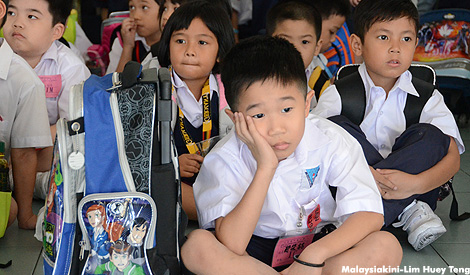
One week before enrolling in college last June, T Nhaveen died in Penang Hospital after the 18-year-old was violently attacked by a gang of youngsters. However, the violence had actually started when he was in high school.
Nhaveen is undoubtedly not the only victim of school bullying. According to a report by the National Human Rights Society (Hakam), the Education Ministry revealed that there were 2,825 cases of bullying in secondary schools in 2014. The number of cases rose to 2,968 in 2015 and it soared to 3,448 in 2016.
Most of the recorded incidents involved physical violence. Cases of bullying could be even higher as some may have gone unreported.
Race, physique, gender expression, sexual orientation and learning disabilities are often the reasons for exclusion and bullying among children.
“There are various reasons which may cause bullying on campus, and some of the reasons seem to be accepted tacitly. This is what we need to think about,” says counsellor Wong Su Zane.
Wong, who has had extensive experience dealing with school bullying cases in her 20-year career, supervises volunteer counsellors in LifeLine Association, an organisation which provides counselling to those in need of support.
Gender-based bullying
Among the various types of school bullying, there are unique social causes and contexts for cases specifically related to gender issues.
Under the influence of the patriarchal system, the bullying of people whose gender expression or sexual orientation are not in congruence with social expectations is more likely to be tolerated, said Wong.
“When children with physical disabilities or learning disabilities suffer from bullying in school, the classmates and teachers always develop a sense of justice and stop the bullying to ‘protect the weak’.
“However, when students’ gender expression is not in line with social expectations, and the school rules even clearly state that an effeminate child ‘can be punished’, teachers may handle the issue with less empathy and tolerance.”
A patriarchal society normally expects that males to be masculine and females to be feminine. Therefore, “feminine men” or “masculine women” in the school and even in society are often subjected to exclusion, discrimination, verbal attacks, and physical abuse.
The patriarchal society invisibly urges boys to "become men" and show their "masculinity", and stronger boys tend to hurt weaker ones to show their strength.

When patriarchal thinking continues to encourage women to show their "femininity", bullying among female students is often closely related to appearance, sexuality, and jealousy.
Wong pointed out that the attitude of teachers and classmates actually play a key role when discriminatory behaviour happens. She added that “silent witnesses” often “assist” to construct the environment of bullying directly or indirectly.
“We all went through primary and secondary schools. Most of us have been involved in bullying or have been bullied, more or less. In most cases, there are ‘silent witnesses’ to the bullying.
“As an ‘insider’, you may not know how to deal with it so you choose to remain silent due to peer pressure. You may be afraid that you will become the next victim if you say or do something wrong.”
She pointed out that the deepest fear of children and teenagers is being excluded by their peers. Therefore, insiders often choose to ignore the problem because they are afraid of being excluded and becoming the next victim.
“Children in primary and secondary schools are in great need of friends. If a child is excluded by his/her classmates, going to school can be very painful for him/her,” she added.
Show concern but don’t overreact
Bullying often begins with "jokes" and this is often camouflaged as such until it turns physical.
“The difference between bullying and joking is that joking may just make you feel uncomfortable, but bullying creates fear of the bullies and subsequently fear of going to school,” Wong explained.
She said when educators or parents hear that a child complains that he or she has been bullied, they should not respond to the child by saying that the other child “is just playing with you”. This may cause the child to avoid raising the issue in future because they feel that their feelings are not being validated.
Wong stressed that teachers and parents should embrace the concerns of the child wholeheartedly and discuss strategies with the child to deal with the issue.
Wong reminded teachers and parents to neither brush off bullying behaviour as “jokes” nor overreact against the perpetrator when they are told about the bullying. This is because overreacting may cause the bullying to escalate.
“Some parents may go to school and confront the bully after they hear that their child has been bullied. In fact, this may increase the (perpetrator’s desire for) revenge, and eventually, put the child in a more dangerous situation.”

Instead of acting directly, Wong suggested that teachers and parents can help the child to find ways to deal with the problem and build their own safety net through discussions.
“Sometimes, the child does not want you to do anything, they just want you to tell them what they can do.
“The teachers or parents can help the child find resources within his or her limited ability. While assisting, the teacher can also enhance his or her ability to respond to the bully.”
When the bullying incident occurs, she said, it is not only the bullies and their immediate actions which need to be dealt with.
"We also have to deal with the bullies and understand the causes of violent behaviour behind such group of juveniles.
“In fact, some members of the group may not intentionally want to hurt others. They are afraid of being excluded from the group if they don’t do so.
“We have had a lot of legal penalties and school rules to punish bullies, but are the punishments really preventing bullying? It may not.”
Wong said that although children should be punished for their wrongdoings, education cannot be carried out solely on the basis of intimidation.
Citing a case she handled before, she said when a school introduced severe punishments such as expelling bullies, the students felt great psychological pressure on whether to report the case, as they may have been afraid of causing their schoolmates to lose their chance to be in school.
“When a small monster is kicked out, they may become a big monster one day,” she said, adding that a teacher should get close to the group of bullies to understand “what they are angry about” or “what they want to prove” and help them control their emotions and behaviour.
Learned behaviour
Wong added that exclusion and discrimination against specific groups, or the habit of using violence to solve emotions, is actually “learned” from somewhere.
“I have seen a four-year-old kid laughing at other kids, saying that ‘Why you behave like this? Are you ‘pondan’ (effeminate)?’ I was shocked but we all know that he definitely learned from somewhere.”
Wong viewed that setting an example is better than setting rules. Therefore, teachers and parents should not use any discriminatory words or stereotypes in daily life.
“When the parents tell their children that ‘boys shouldn’t cry, boys must be masculine and can’t speak in a soft manner’, the children form a specific understanding of social norms. When they see someone who is not in line with the norm, don’t you think they will have some reaction?”
Cases of death resulting from being bullied over gender expression are not new. In 2004, a Taiwanese teenager named Ye Yongzhi (photo), who had been frequently forced to take off his pants to “identify his gender”, was found lying in his blood in the school toilet. He died after being sent to the hospital.

His death sparked intense public debate and the Taiwanese legislature amended the law to include sexual or gender diversity in the school curriculum four years after.
Wong agreed that it is important to include gender diversity and sexuality education in school syllabi, and that students should learn how to respect one another by understanding differences among individuals.
The counsellor was involved in the formulation of a related syllabus for the National Service training programme a few years ago. She admitted that promoting gender diversity and sexuality education on campus is not an easy task and that her precursors have tried hard to do so since the 1990s.
Citing her friends who are now working as counselling teachers in school, Wong said that some of them have introduced gender diversity and sexuality education with some interactive methods such as telling stories in order to create a more inclusive atmosphere in school.
“If we always think that there is no way to achieve it, then it will not be achieved.” - Mkini


No comments:
Post a Comment
Note: Only a member of this blog may post a comment.